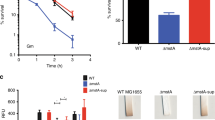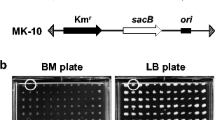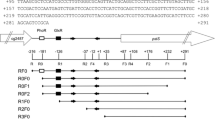Abstract
The effect of glucose and other carbon sources on thiosulfate reduction and on the expression ofphs bySalmonella typhimurium was examined. Glucose repressed both H2S production from thiosulfate and methyl viologen-linked thiosulfate reductase activity. Cyclic AMP (2 mM) in the growth medium restored both activities. Cyclic AMP was essential for both activities in acya mutant. Glucose and many other sugars repressedphs expression in both Cya+ and Cya− phs::Mu d1(Apr lac) operon fusion mutants. Increasing cyclic AMP to 10 mM increasedphs expression in the presence of some, but not all, sugars. It appears that catabolite repression of thiosulfate reduction inS. typhimurium involves more than a simple requirement for cyclic AMP.
Similar content being viewed by others
Literature Cited
Barrett EL, Riggs DL (1982) Evidence for a second nitrate reductase activity that is distinct from the respiratory enzyme inSalmonella typhimurium. J Bacteriol 150:563–571
Bradford MM (1976) A rapid and sensitive method for the quantitation of microgram quantities of protein utilizing the principle of protein-dye binding. Anal Biochem 72:248–254
Bulmash JM, Fulton M (1964) Discrepant tests for hydrogen sulfide. J Bacteriol 88:1813
Clark MA, Barrett EL (1987) Thephs gene and hydrogen sulfide production bySalmonella typhimurium. J Bacteriol (in press)
Davis RW, Botstein D, Roth JR (1980) A manual for genetic engineering advanced bacterial genetics. Cold Spring Harbor NY: Cold Spring Harbor Laboratory
Dessein A, Schwartz M, Ullman A (1978) Catabolite repression inEscherichia coli mutants lacking cyclic AMP. Mol Gen Genet 162:83–88
Epstein W, Rothman-Denes LB, Hesse J (1975) Adenosine 3′∶5′cyclic monophosphate as mediator of catabolite repression inEscherichia coli. Proc Natl Acad Sci USA 72:2300–2304
Guidi-Rontani C, Danchin A, Ullmann A (1980) Catabolite repression inEscherichia coli mutants lacking the cyclic AMP receptor protein. Proc Natl Acad Sci USA 77:5799–5801
Jamieson DJ, Sawers RG, Rugman PA, Boxer DH, Higgins CF (1986) Effects of anaerobic regulatory mutations and catabolite repression on regulation of hydrogen metabolism and hydrogenase isoenzyme composition inSalmonella typhimurium. J. Bacteriol. 168:405–411
Lee JH, Dobrogosz WJ (1983) Effects of aerobic and anaerobic shock on catabolite repression in cyclic AMP suppressor mutants ofEscherichia coli. J Bacteriol 154:992–994
Miller JH (1972) Experiments in molecular genetics. Cold Spring Harbor NY: Cold Spring Harbor Laboratory
Postma PW, Lengeler JW (1985) Phosphoenolpyruvate: carbohydrate phosphotransferase system of bacteria. Microbiol Rev 49:232–269
Ullmann A, Danchin A (1983) Role of cyclic AMP in bacteria. Adv Cyclic Nucleotide Res 15:1–53
Ullmann A, Tillier F, Monod J (1976) Catabolite modulator factor: a possible mediator of catabolite repression in bacteria. Proc Natl Acad Sci USA 73:3476–3479
Unden G, Guest JR (1984) Cyclic AMP and anaerobic gene expression inEscherichia coli. FEBS Lett 170:321–325
Vogel HJ, Bonner DM (1956) Acetylornithinase ofEscherichia coli: partial purification and some properties. J Biol Chem 218:97–106
Voll MJ, Shiller LM, Castrilli J (1974)his-Linked hydrogen sulfide locus ofSalmonella typhimurium. J Bacteriol 120:902–905
Voll MJ, Cohen LA, Germida JJ (1979)his-Linked hydrogen sulfide locus ofSalmonella typhimurium and its expression inEscherichia coli. J Bacteriol 139:1082–1084
Wanner BL, Kodaira R, Neihardt FC (1978) Regulation of thelac operon expression: reappraisal of the theory of catabolite repression. J Bacteriol 136:947–954
Author information
Authors and Affiliations
Rights and permissions
About this article
Cite this article
Clark, M.A., Barrett, E.L. Catabolite repression of thiosulfate reduction bySalmonella typhimurium . Current Microbiology 16, 27–31 (1987). https://doi.org/10.1007/BF01568165
Issue Date:
DOI: https://doi.org/10.1007/BF01568165




